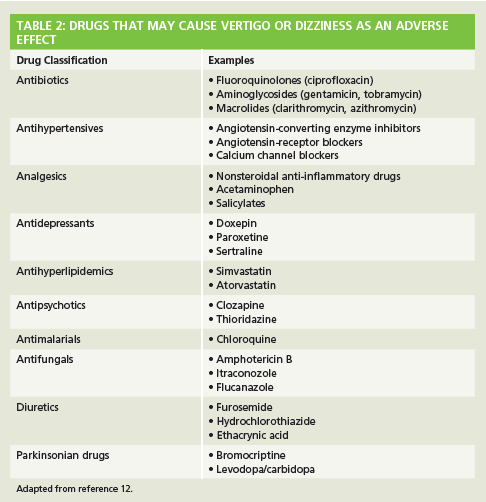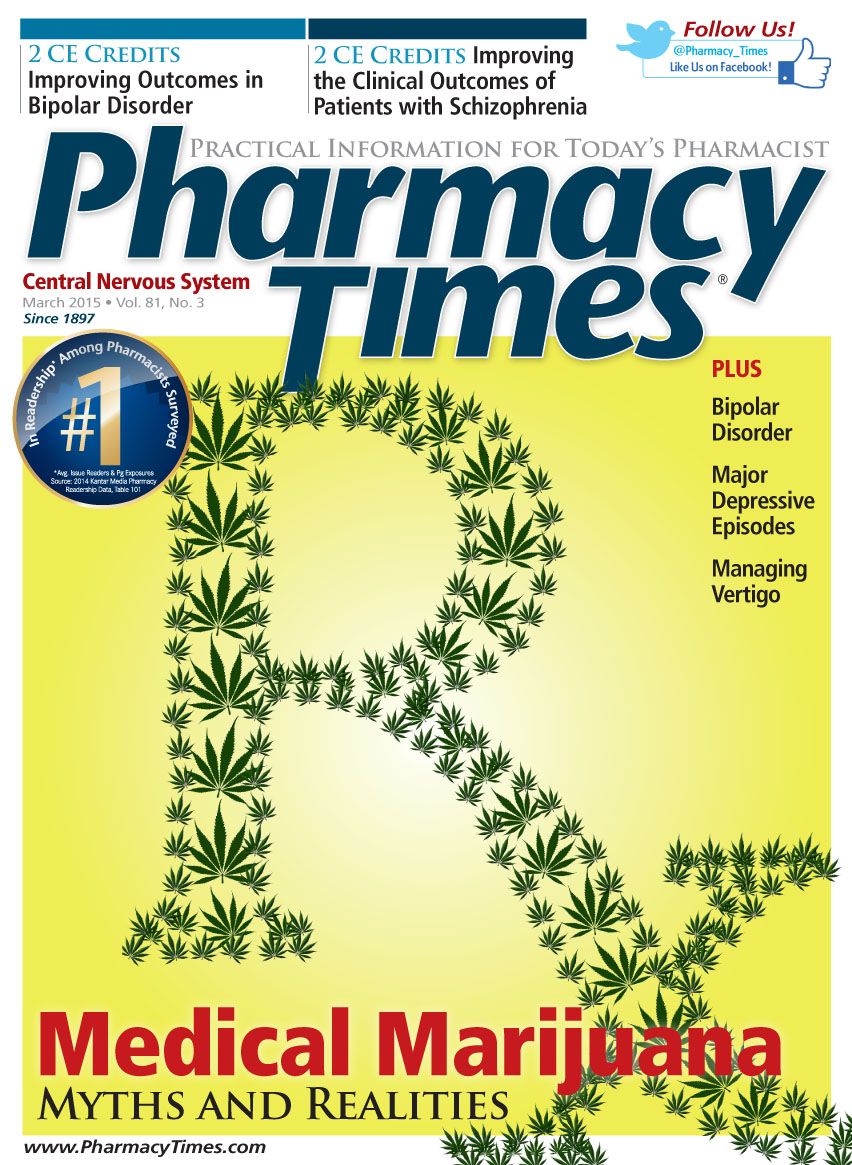Publication
Article
Pharmacy Times
Vertigo: Helping Patients Identify and Manage It
Author(s):
Vertigo can reduce quality of life and increase the risk of falls and injury.
Vertigo can reduce quality of life and increase the risk of falls and injury.
Experiencing vertigo—the illusion of spinning, rotating, or rocking movement of one’s self or the environment when there is no movement— can be quite alarming.1,2 Although the terms vertigo and dizziness are often used interchangeably, according to the Vestibular Disorders Association, dizziness is a sensation of lightheadedness, faintness, or unsteadiness, whereas vertigo involves a rotational or spinning component and is the perception of movement of either the self or the environment.3 A specific type of dizziness, vertigo represents about 25% of all dizziness events and is a very common symptom that results in patients seeking medical care from their primary health care provider.4 The severity of vertigo can range from mild to severe, and the condition can last from a few seconds to several weeks.
Pathophysiology, Classification, and Clinical Signs
Vertigo is classified as either peripheral or central, according to where the problem originates (Online Table 11-4). The most common form of vertigo is benign paroxysmal positional vertigo (BPPV), a type of peripheral vertigo that is characterized by brief episodes of mild to intense dizziness.5,6 BPPV occurs when small calcium carbonate crystals called otoconia become dislodged from their normal location in the inner ear sensory organ called the utricle.7-9 Once detached, the otoconia collect in one of the semicircular canals and stimulate hair cells, most commonly in the posterior semicircular canal, but also sometimes in the superior semicircular canal, thus creating the illusion of motion.7-9
TABLE 1: CLASSIFICATION OF VERTIGO
Peripheral vertigo results from a problem in the vestibular labyrinth or semicircular canals, which are the areas of the inner ear that control balance. The issue may also involve the vestibular nerve, which connects the inner ear to the brainstem.
Causes of peripheral vertigo
- Benign positional vertigo, also known as benign paroxysmal positional vertigo (BPPV)
- Head injury
- Ménière’s disease (vertigo associated with hearing loss and tinnitus caused by fluid buildup within the inner ear)
- Use of certain medications (salicylates, aminoglycosides, antihypertensives, antidepressant, diuretics, cisplatin)
- Labyrinthitis
- Inflammation of the vestibular nerve
Central vertigo results from an issue in the brain, typically the brain stem or the cerebellum.
Causes of central vertigo
- Migraine
- Stroke
- Tumor
- Multiple sclerosis
- Disease of the blood vessels
- Use of certain drugs (salicylates, alcohol, and anticonvulsants)
Adapted from references 1-4.
Patients with BPPV may complain of dizziness, lightheadedness, or feeling a spinning motion or a sense of imbalance; the spinning sensation may cause nausea and vomiting in moderate to severe cases, along with nystagmus (involuntary eye movements).4,7-9 Depending on the cause, some patients with vertigo may also experience symptoms such as hearing loss, tinnitus, a feeling of fullness in the ears, and difficulty focusing.7 An episode may be triggered by movements such as bending the head forward to look down or rolling over or sitting up in bed.8
Aging, a head injury, or other disorders of the inner ear can increase one’s risk for developing BPPV.7 An estimated 50% of individuals 65 years and older experience episodes of BPPV that can lead to falling and subsequent injury.8,10 According to the Vestibular Disorders Association, BPPV is not a life-threatening condition, but it can be bothersome, can negatively impact an individual’s overall quality of life, and can increase the risk for falls and injury.10
BPPV occurs twice as often in women as in men.11 It typically affects older patients and may result from a head injury, decreased blood flow in the brain, an episode of labyrinthitis, ear surgery, or prolonged bed rest.11 Episodes may be short-lived or last a lifetime, and vary in frequency, intensity, and duration.10 Other common vestibular disorders that cause vertigo are Ménière’s disease and vestibular neuritis.10

Many medications have the potential adverse effects of dizziness and vertigo (Table 212). Pharmacists are in a pivotal position to identify those agents and make clinical recommendations to physicians regarding therapeutic substitutions or adjustments if possible or when needed. The most common drug classes associated with dizziness and vertigo are anticonvulsants, antihypertensives, antibiotics, antidepressants, antipsychotics, and anti-inflammatories.12,13
Treating and Preventing BPPV
When possible, the cause of vertigo should be identified and treated. Some cases resolve or disappear without treatment, whereas others require treatment. Once the cause is identified, treatment is aimed at relieving symptoms and may include the “wait- and-see approach,” the use of medication for symptomatic relief of nausea and vomiting, vestibular rehabilitation, balance training, and canalith repositioning (also known as Epley maneuver).10,13
Canalith repositioning, which is considered very effective in resolving BPPV, involves moving the patient’s head into certain positions to encourage movement of the canaliths to a part of the ear where they will be reabsorbed.13 Because canalith repositioning involves rapid movements, the procedure itself may cause vertigo; therefore, some patients may require pretreatment with antianxiety medications (eg, diazepam) or antiemetics before the procedure.10,13 Vestibular rehabilitation is a form of physical therapy that enables patients to learn various exercises that aid in retraining the brain to compensate for or adjust to changes in the vestibular system.10 The American Academy of Otolaryngology—Head and Neck Surgery does not recommend using vestibular suppressant medications, including antihistamines and benzodiazepines, to control BPPV.10,14 In addition, the American Academy of Neurology reports that there is no evidence supporting the routine use of medication to treat BPPV.10,15
Pharmacist’s Role
Pharmacists are in a pivotal position to identify patients at risk for developing vertigo, especially vertigo related to medications, and can direct patients to seek further medical care when warranted. BPPV is very common among elderly patients, so patients and caregivers should be advised to use caution and avoid operating hazardous machinery because vertigo can interfere with one’s ability to drive and can cause falls. During counseling, pharmacists can advise patients about nonpharmacologic measures that may prevent worsening of symptoms during an episode of vertigo. They should also advise patients to sit still or lie down when symptoms occur, change positions slowly, resume activity or movement gradually, use support devices such as canes and walkers (if needed), and avoid bright lights, sudden changes in position, and reading.16,17
It is important for patients experiencing vertigo to be evaluated by their primary health care provider to find the underlying cause, especially if episodes are recurring. While the majority of cases are easily treated, patients with vertigo should be advised to seek immediate medical care if they experience double vision, headache, difficulty speaking, or weakness.18
Ms. Terrie is a clinical pharmacist and medical writer based in Haymarket, Virginia.
References
1. Dizziness and vertigo. The Merck Manual Professional Edition website. www.merckmanuals.com/professional/ear_nose_and_throat_disorders/approach_to_the_patient_with_ear_problems/dizziness_and_vertigo.html. Accessed February 5, 2015.
2. Dizziness and motion sickness. American Academy of Otolaryngology—Head and Neck Surgery website. www.entnet.org/content/dizziness-and-motion-sickness. Accessed February 5, 2015.
3. Dizziness, vertigo and disequilibrium. Vestibular Disorders Association website. http://vestibular.org/node/2. Accessed February 5, 2015.
4. Vertigo and dizziness. Beaumont Health System website. http://neurosciences.beaumont.edu/files/neuro/imce/P5187k36_Vertigo_Dizziness.pdf. Accessed February 5, 2015.
5. Benign positional vertigo. PubMed Health website. www.ncbi.nlm.nih.gov/pubmedhealth/PMH0002393/. Accessed February 5, 2015.
6. Benign paroxysmal positional vertigo (BPPV). Mayo Clinic website. www.mayoclinic.org/diseases-conditions/vertigo/basics/definition/con-20028216. Accessed February 5, 2015.
7. Benign positional vertigo. Medline Plus website. www.nlm.nih.gov/medlineplus/ency/article/001420.htm. Accessed February 5, 2015.
8. Benign paroxysmal positional vertigo. Cleveland Clinic website. http://my.clevelandclinic.org/services/head-neck/diseases-conditions/hic-benign-paroxysmal-positional-vertigo. Accessed February 5, 2015.
9. Benign paroxysmal positional vertigo. The Merck Manual Professional Edition website. www.merckmanuals.com/professional/ear_nose_and_throat_disorders/inner_ear_disorders/benign_paroxysmal_positional_vertigo.html. Accessed February 5, 2015.
10. Benign paroxysmal positional vertigo. Vestibular Disorders Association website. http://vestibular.org/understanding-vestibular-disorders/types-vestibular-disorders/benign-paroxysmal-positional-vertigo. Accessed February 5, 2015.
11. Rabie A, Foster CA. Canalith-repositioning maneuvers. Medscape website. http://emedicine.medscape.com/article/82945-overview. Accessed February 5, 2015.
12. Chimirri S, Aiello R, Mazzitello C, et al. Vertigo/dizziness as a drugs' adverse reaction. J Pharmacol Pharmacother. 2013;4(5): S104—S109.
13. Vertigo: causes, symptoms and treatment. Medical News Today website. www.medicalnewstoday.com/articles/160900.php. Accessed February 5, 2015.
14. Fife TD, Iverson DJ, Lempert T, et al. Practice parameter: therapies for benign paroxysmal positional vertigo (an evidence-based review): report of the Quality Standards Subcommittee of the American Academy of Neurology. Neurology. 2008;70(22):2067-2074. http://www.neurology.org/content/70/22/2067.full. Accessed February 5, 2015.
15. Bhattacharyya N, Baugh RF, Orvidas L, et al. Clinical practice guideline: benign paroxysmal positional vertigo. Otolaryngol Head Neck Surg. 2008;139(5; suppl 4):S47—S81.
16. Agus S, Benecke H, Thum C, Strupp M. Clinical and demographic features of vertigo: findings from the REVERT Registry. Front Neurol. 2013;4:48. www.ncbi.nlm.nih.gov/pmc/articles/PMC3650561/. Accessed February 5, 2015.
17. Vertigo-associated disorders. Medline Plus website. www.nlm.nih.gov/medlineplus/ency/article/001432.htm. Accessed February 5, 2015.
18. Cunha JP. Vertigo medications. eMedicine website. www.emedicinehealth.com/vertigo/page7_em.htm#vertigo_medications. Accessed February 5, 2015.







